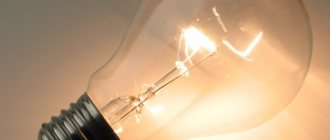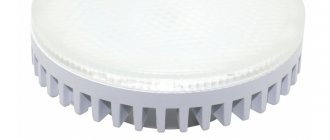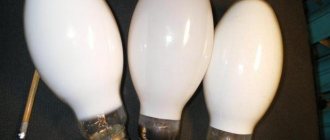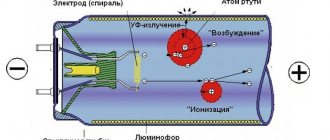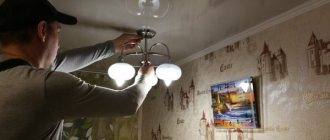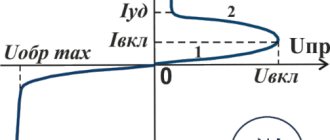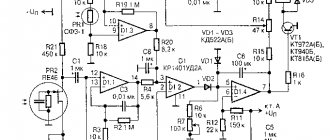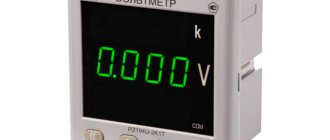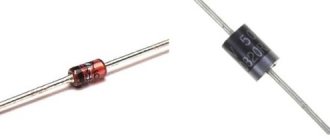What is this lighting device? Essentially, it is a glass tube sealed on both sides. Its inner surface is treated with a phosphor, air is pumped out of it and gas - argon - is added. Also, only one drop of mercury is added inside. It turns into vapor under the influence of temperature.
In order for the lamp to glow, it is necessary to apply an electric current inside its structure, which will raise the temperature. Therefore, electrodes are installed in the glass tube, which are tungsten wires twisted in the form of a spiral. Tungsten is coated with a special alloy of barium or strontium salt oxide. It is this layer that increases the service life of the electrodes. Here, two so-called hard electrodes are installed parallel to the spiral. They are nickel. Each such electrode is connected at one end to one of the ends of the spiral.
How does the glow happen? Firstly, a specific mixture of argon gas and mercury vapor is formed inside the flask. In fact, this is a kind of plasma that emits a light flux both in the visible parts of the spectrum and in the invisible (ultraviolet). Secondly, it is the phosphor applied to the inner walls of the bulb that converts invisible light rays into visible ones. And the better the applied phosphor layer, the longer the fluorescent tube itself works.
What it is
Lamp LB 36 is a 36-watt low-pressure fluorescent lamp. It is one of the most popular models because it is simple, reliable and cheap. Fluorescent lamps with a power of 15-80 watts belong to the category of general-purpose lamps. Their main task is to imitate natural light.
LB lamps look like long thin tubes
Important! The modern analogue of a 36 V lamp is the outdated 40 V lamp. Modern technologies make it possible to reduce the power without changing other characteristics.
The name “Luminescent” is due to the fact that the glow of the light bulb comes from a layer of phosphor on the inner wall of the glass tube, and not from the heated gas inside. Luminescence is secondary radiation that appears from the action of a flow of positively infected ions.
The abbreviation stands for as follows:
- L - fluorescent light bulb;
- B - white.
There are other color abbreviations: D - daytime, E - natural, U - universal, HB - cool white, TB - warm white. The marking may also contain other letters: K (red), Z (green), G (blue), S (blue). Separately referred to as UV or ultraviolet.
You can recognize a light bulb by the mark on it
A fluorescent lamp is a gas-charging light source. The glow is created by an electrical discharge in mercury vapor, which creates ultraviolet radiation. The LB operates from an AC power supply with a voltage of 127-220 V and a frequency of 50 Hz.
According to the color temperature of LB light bulbs, they can be:
- Warm white (2.7-3.4 thousand K). The color is soft, soothing and relaxing, with a yellowish tint;
- Natural white (3.4-5.6 thousand K). Cooler and sharper, brighter;
- Cool white (5.6-6.4 thousand K). It has a bluish tint, is cool and clear, and increases performance.
Light can be warm or cold
Kinds
Experts divide all fluorescent lamps into two categories according to their characteristics:
- General purpose. These are devices with a power ranging from 15-80 watts.
- Special: up to 15 watts are devices that are considered low-power, and over 80 watts are super-powerful.
The main characteristic of general purpose lamps is the imitation of natural light. That is, almost complete compliance with its color and spectral characteristics.
Fluorescent lamps are divided according to several technical indicators.
- According to the light discharge into glow and arc.
- By type of radiation: natural light, ultraviolet and color.
- According to the shape of the glass tube, tubular and shaped.
- According to the distribution of luminous flux: non-directional and directional. By the way, directional ones include fluorescent light sources of the slot type, panel type, reflector type, and so on.
Now regarding energy saving. When the conversation turns to a 36 W lamp, it must be said that this is an analogue of exactly the same device only with a power of 40 W. Why? Modern technologies make it possible to change the design features of lighting devices through the use of higher quality and modern materials, plus modified technological processes. So, fluorescent lamps from the energy-saving category use a higher-quality phosphor layer and a new design (more efficient) of the electrode block. This led to the appearance on the market of fluorescent lamps with lower power, but with a more efficient luminous flux. And how big an effective addition is is to reduce the diameter of the glass tube itself by 1.6 times.
Now, to understand the markings of fluorescent lamps, you need to look at the figure below. It clearly shows what the letter and numeric markings mean.
Marking
Since we are interested in the technical characteristics of a 36 W fluorescent lamp, we will analyze the LB-36 marking as an example. The letter “L” means that it is a fluorescent lamp, the letter “B” means that it is white, and accordingly 36 is its power.
Attention! LB fluorescent tubes are considered the most efficient in terms of luminous flux when compared with other models of the same power. Therefore, they are most often installed in rooms where high visual stress is required from personnel.
As for other types, we can note:
- LTB with warm white color. Such light sources have a slightly pink tint.
- LD – close to daylight. Accordingly, LDCs are color analogues of this type.
- LCB (cold white) is an intermediate option between LB and LD.
And some more technical characteristics:
- Brightness (average) – 6-11 cd/m².
- Such lamps emit a variable luminous flux (meaning over time) when connected to a network with alternating voltage.
- The pulsation coefficient for LB is 23%, for LDC – 43%.
- If you increase the rated voltage of the network, the brightness of the lamp itself also increases. Of course, the same applies to power.
- If the luminous flux of a fluorescent lamp after 70% of its operating time is 70% of the nominal value, then this lamp is of high quality.
- 36 W lamp life: minimum – 4800 hours, average – 12000 hours.
By the way, European markings are very different from Russian ones. Here the degree of light emission is marked with numbers. But the most interesting thing is that each manufacturer has different markings. For example, 765 means a cold color, 640 means a warm color. U: 54 is cold, 33 is warm.
Advantages and disadvantages of the lamp
The advantages of LB include:
- Increased luminous efficiency, high efficiency - approximately 2-3 times more than incandescent light bulbs. On average, a fluorescent light bulb produces 5-7 times more light than a regular incandescent light bulb;
- Covering a large area. One light bulb can illuminate a large area;
- Economical electricity consumption. A lower wattage LB consumes less electricity, yet it produces the same amount of light as stronger incandescent lamps;
- Availability of color and special models (bactericidal, ultraviolet). They can be used in medicine, the food industry, and for decorating premises;
- Long service life. The minimum period is 4.8 thousand hours, the maximum is 20 thousand. On average, light bulbs will last about 12 thousand hours;
You may be interested in this Features of a lamp with a motion sensor
LB 36 lamps are popular
Important! The service life directly depends on the number of turns on and off. Typically, in public places, lamps break down faster.
- Low price: the price is 50-100 rubles.*
The disadvantages are:
- The lamp contains mercury inside, which makes it dangerous for humans. Lamps can only be disposed of through special collection points for mercury lamps. If a lamp breaks, you will need to be careful when cleaning up the aftermath;
- A special choke is required for operation, due to which the final cost increases;
- Any malfunction can cause the lamp to flicker, which has a bad effect on vision and well-being, causing headaches and fatigue.
Connection diagram
Fluorescent lamps cannot simply be plugged into the electrical network: in order for it to light up, the temperature of the electrodes must rise and a short-term high-voltage pulse must appear. To do this, use a circuit with an electromagnetic ballast (throttle and starter), which was discussed in this article.
Connection diagram for a fluorescent lamp with a choke and starter
The ignition of a 36w fluorescent lamp occurs according to the following algorithm:
- Immediately after voltage is applied, current begins to flow through the inductor, the right electrode, the starter, and the left electrode. In this case, a glow discharge occurs in the starter and the contacts heat up.
- Under the influence of temperature, the bimetallic contact of the starter bends and connects with the stationary one.
- At the moment the contacts are connected, the starter resistance sharply decreases and the current in the circuit increases.
- Due to the increased current, the electrodes begin to heat up and emit electrons. In addition, energy is stored at the throttle.
- Since there is no longer a glow discharge in the starter, the contacts cool down and open.
- When the starter contacts open, the voltage across the inductor increases due to self-induction emf. Due to this, an electrical discharge occurs in the mercury vapor, and after some time the lamp begins to operate in operating mode.
This connection scheme has a number of disadvantages:
- inability to turn on at low temperatures;
- noise at start-up and during operation;
- startup requires a long time, which increases with increasing operating time of the product;
- pulsation of light during operation, which negatively affects the health of the visual system.
The product can also be connected using a throttleless circuit using electronic ballast. The connection diagram is usually indicated by the manufacturers on its housing.
Technical specifications
A 36 V LB lamp is connected to an alternating current source using starting control equipment. It has poor color rendering and produces white light with a slight purple tint.
Multi-colored light bulbs can be used in advertising and decoration
The technical specifications are as follows:
- Full length: 121.36cm, clear tube length only: 19.94cm for L;
- Diameter: 2.6 cm;
- Power: 36 W;
- Lamp voltage: 103 V;
- Service life: 12 thousand hours;
- Luminous flux: 2800 lm;
- Base type: G13.
Replacing fluorescent tubes with LED ones
Replacing a fluorescent light source with an LED lamp doubles energy savings and also eliminates extraneous noise. To replace a fluorescent lamp with an LED one, it is advisable that they have the same G13 sockets (less often it can be G5), since this will not require replacing the sockets. If your lamp has an electronic ballast, you need to remove it from the circuit and connect the lamps directly to 220V.
Typical connection diagram for tubular LED lamps
To replace a light source in an old-style lamp with electronic ballasts, that is, with an ordinary choke and starter, you need:
- Remove the starter.
- Remove the inductor from the circuit or short-circuit its contacts.
- Install LED tube lamp.
The starter must be removed to avoid a short circuit when turned on.
Scheme for converting a lamp from fluorescent tubular lamps to LED
Fluorescent lamps save energy, but their disposal requires additional costs due to the fact that they contain mercury. Therefore, it is worth considering replacing such light sources with LED ones, which are more economical and environmentally friendly.
Operating principle
The LB lamps glow as follows:
- The light bulb is connected to the mains, the temperature of the coil begins to rise;
- Liquid mercury is heated and turns into steam, mixed with argon;
- After reaching the desired temperature, a discharge appears and is drawn between two electrodes. This produces an arc discharge;
- This discharge begins to glow with UV radiation. It is invisible to people, but, passing through a layer of phosphor (it absorbs UV radiation and emits light), it is converted into a white luminous flux.
Lamp device
The device is a long glass tube. The light bulb consists of several parts:
- An elongated narrow flask made of quartz glass. The inside is coated with a white phosphor, which makes the lamp look opaque. To enhance the quality of the light flux, there can be several layers of phosphor (3 or 5). The air is pumped out of the tube, instead argon and a drop of mercury are pumped in, the latter turns into steam with increasing temperature;
You might be interested in: Features of electronic ballast
A fluorescent lamp consists of several parts
Important! The pressure inside the bulb does not exceed 400 Pa, which is why they are called low-pressure lamps.
- 2 bases with output contacts. They are located on both sides of the tube and are connected to the mains;
- Electrodes: they are soldered at both ends of the bulb. They are spiral-twisted tungsten wires and are additionally coated with barium or strontium salt oxide to protect and increase service life. Hard nickel electrodes are mounted parallel to the tungsten electrodes. They are connected at one end to tungsten.
Also for connection you need a choke - a ballast, without which the lamps will not work. Its task is to ensure the stability of the current at its variable value.
The principle of operation is to pass a charge through mercury vapor
LB, LD RF fluorescent lamps
Marking of fluorescent lamps:
L - fluorescent lamp; B - white; D - daytime color; U - universal.
Execution:
1 - straight rod; 2 - U-shaped rod.
Specifications:
| Name | Power, W | Current, A | Voltage, V | Overall dimensions, mm | Luminous flux, lm | Service life, hour | Execution | ||
| D | L1 | L | |||||||
| LD-18 | 18 | 0,37 | 57 | 26 | 604 | 589,8 | 880 | 12000 | 1 |
| LB-18 | 18 | 0,37 | 57 | 26 | 604 | 589,8 | 1060 | 12000 | 1 |
| LD-20 | 20 | 0,43 | 57 | 38 | 604 | 589,8 | 880 | 12000 | 1 |
| LB-20 | 20 | 0,43 | 57 | 38 | 604 | 589,8 | 1060 | 12000 | 1 |
| LD-36 | 36 | 0,43 | 103 | 26 | 1213,6 | 1199,4 | 2300 | 12000 | 1 |
| LB-36 | 36 | 0,43 | 103 | 26 | 1213,6 | 1199,4 | 2800 | 12000 | 1 |
| LD-40 | 40 | 0,67 | 103 | 38 | 1213,6 | 1199,4 | 2300 | 12000 | 1 |
| LB-40 | 40 | 0,67 | 103 | 38 | 1213,6 | 1199,4 | 2800 | 12000 | 1 |
| LD-65 | 65 | 0,87 | 110 | 38 | 1514,2 | 1500 | 3750 | 12000 | 1 |
| LB-65 | 65 | 0,87 | 110 | 38 | 1514,2 | 1500 | 4600 | 12000 | 1 |
| LD-80 | 80 | 0,87 | 99 | 38 | 1514,2 | 1500 | 4250 | 12000 | 1 |
| LB-80 | 80 | 0,87 | 99 | 38 | 1514,2 | 1500 | 5200 | 12000 | 1 |
Advantages and disadvantages
.
Mercury lamps are distinguished by high luminous efficiency (2–3 times greater than that of general-purpose incandescent lamps), long service life and compactness, making them well suited for regulating the luminous flux.
Their disadvantages are the high cost of the lamp and auxiliary equipment, a bluish-green tint of light and a slow restart.
The color of a mercury lamp is corrected by using an internal phosphor coating.
Fluorescent lamps.
Fluorescent lamps consist of the following main parts: a glass cylinder, two bases (with lead contacts) at both ends of the cylinder and two heated cathodes (electronic emitters) made of tungsten filament or steel tube.
The cylinder is filled with mercury vapor and inert gas (argon); A phosphor coating is applied to the inner walls of the cylinder, which converts the ultraviolet radiation of the gas discharge into visible light.
The design of the lamp is typical of the most common 40-W lamps.
The lamp operates as follows.
An electrode at one end of the lamp emits electrons, which fly along the lamp at high speed until they collide with an encountered mercury atom.
In doing so, they knock the electrons of the atom into a higher orbit.
When the ejected electron returns to its original orbit, the atom emits ultraviolet radiation.
The latter, passing through the phosphor, is converted into visible light.
FLUORESCENT LAMP - a typical cold cathode lamp design designed for below average currents. 1
- mercury;
2
– stamped glass leg with electrical inputs;
3
– pumping tube (during manufacture);
4
– output pins;
5
– end socket;
6
– cathode with emitter coating. The tube is filled with inert gas and mercury vapor. The inner walls of the tube are coated with phosphor.
Types of lamps.
Fluorescent lamps are divided into two groups according to the type of electrodes: with heated cathodes and with cold cathodes.
In lamps with heated cathodes, which are designed for high currents (1–2 A), as a rule, spiral activated tungsten filaments are used.
Cold cathode lamps have cylindrical electrodes coated with emitter materials and are designed for lower currents.
The average service life of lamps with heated cathodes depends on the operating time per start: 7500 hours with 3 hours of operating time per start and more than 18,000 hours in continuous mode.
For lamps with cold cathodes, the service life does not depend on the number of starts and reaches 25,000 hours.
Lamps with heated cathodes, according to the method of their start-up, are divided into lamps with pre-heating, quick start and instant start.
Like all other gas-discharge devices, lamps with heated cathodes cannot be connected to a power source without a ballast device that limits the current.
Preheat lamps also require a starter; When such a lamp is started, the starter closes, and the cathodes connected in series are connected to the power supply, so that current passes through them.
Once the cathodes are hot enough to emit electrons, the starter automatically opens and the lamp lights up.
Under favorable conditions, the entire start-up takes a few seconds.
In quick-start lamps, the cathodes are constantly heated, and a discharge occurs when the voltage increases.
No starters are required and start-up times are significantly faster than pre-heated lamps.
Instant start lamps do not require heating of the cathodes or the starter.
Simply, an increased voltage is applied to the cathode, which causes the emission of electrons and ignition of a discharge in the lamp.
Scope of application
They are mainly used for lighting large industrial and residential premises, mounted on the street and outside buildings. They are installed in shops, offices, showrooms and warehouses; multi-colored ones are used in billboards and in shows; bactericidal ones are used in medicine and the food industry to sterilize objects and disinfect air. For example, such light bulbs are installed in refrigerator windows for better storage of fresh meats or cheeses.
LB lamps are used in industrial and office premises
Price
LB 36 V light bulbs are among the cheapest and highest quality. Their average cost does not exceed 100 rubles. In addition to the light bulb, you will need to buy a choke, and, if necessary, pay for delivery, paying extra for the “fragility” of the product.
The manufacturer usually sells LB in 36 small batches of 25 pieces; stores make retail sales.
Paws can be sold wholesale or individually
The LB 36 lamp is a 36-watt fluorescent light bulb, a fairly popular and in-demand model. It is characterized by a combination of low cost with high quality and good efficiency. Despite some disadvantages associated with the use of mercury, the lamp has many advantages.
*Prices are current as of October 2022.
